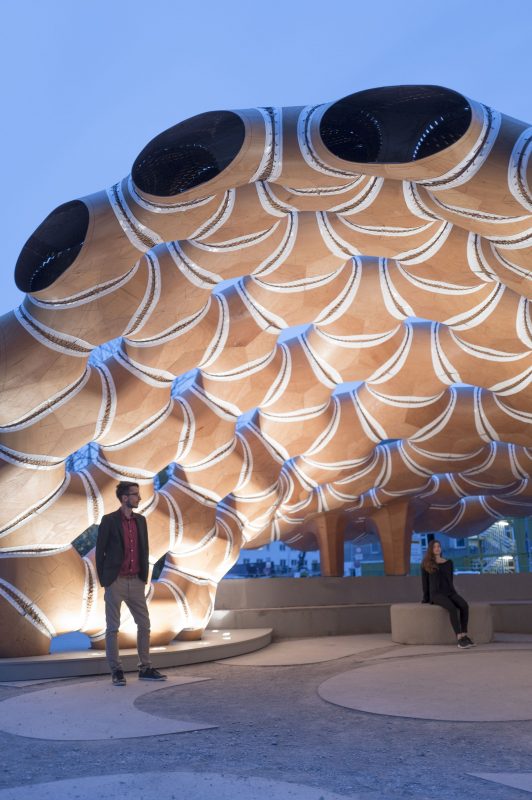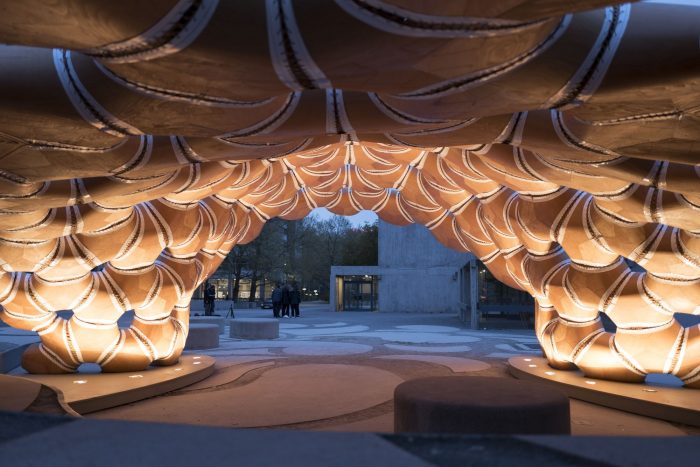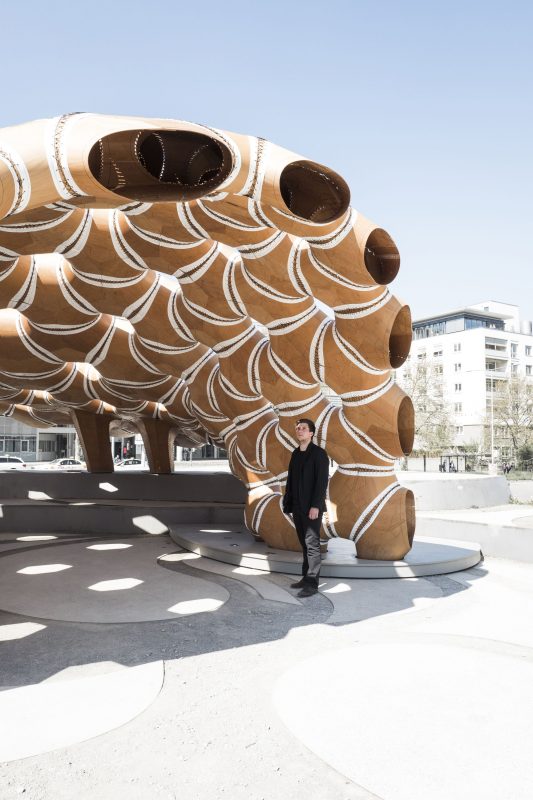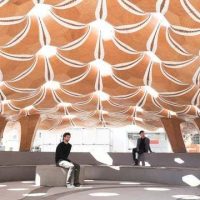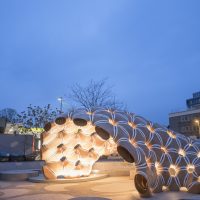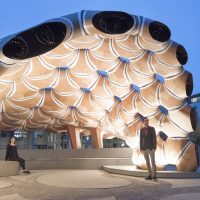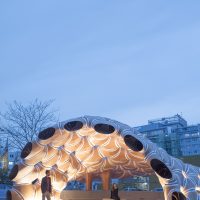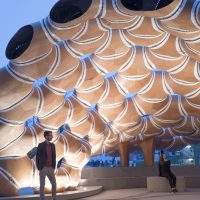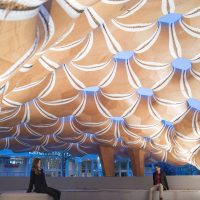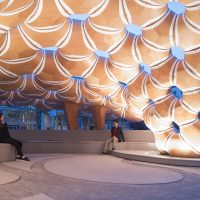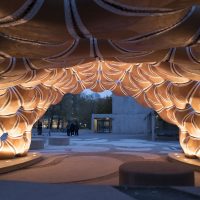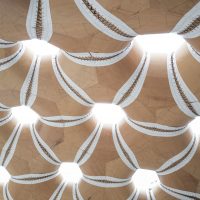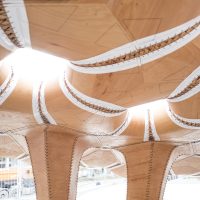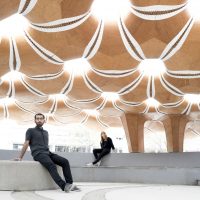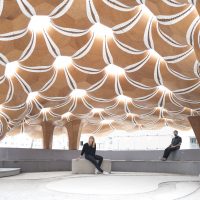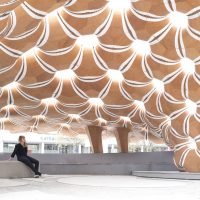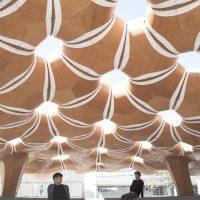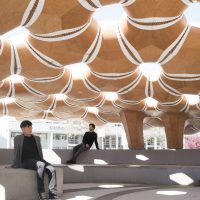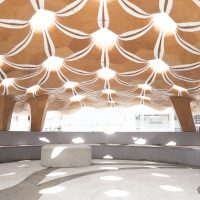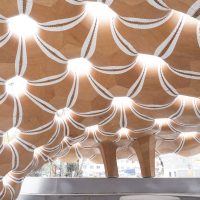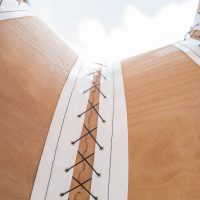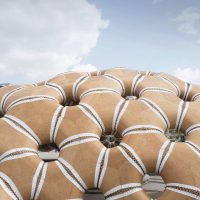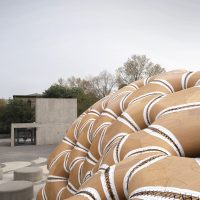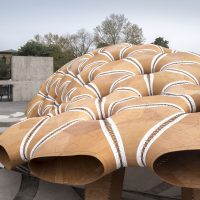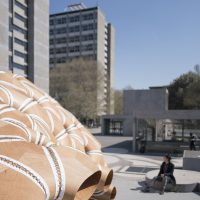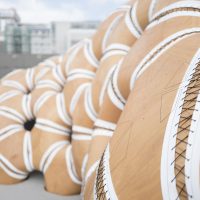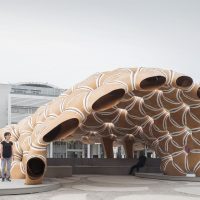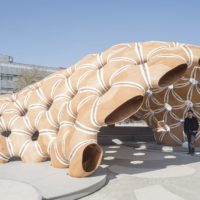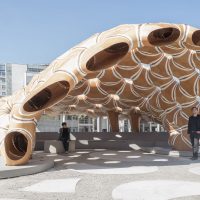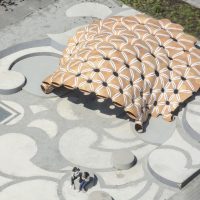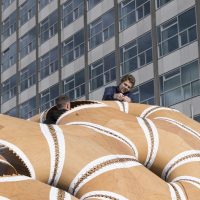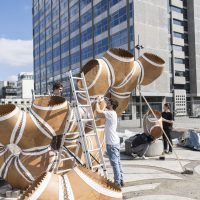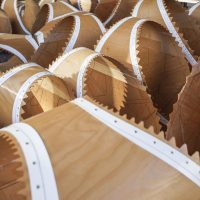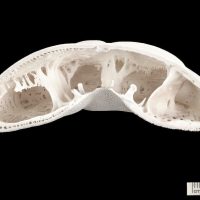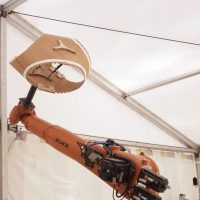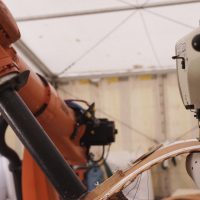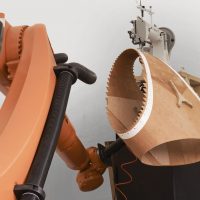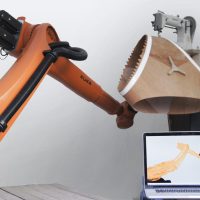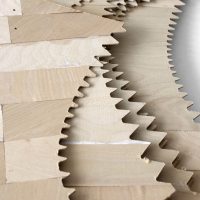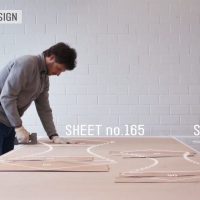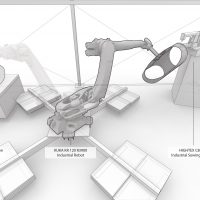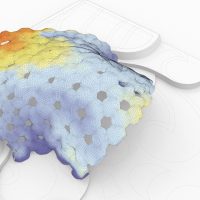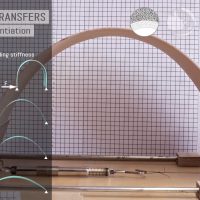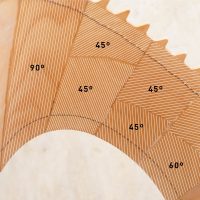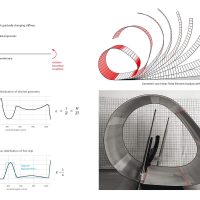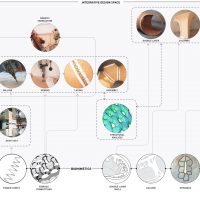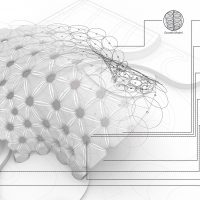ICD/ITKE Research Pavilion 2015-16
Some of the most splendid manifestations of biomimetic architecture can be seen in examples where the mimicry is not just a superficial replication but is a creation that comes out of a holistic understanding of the specimen itself. From Gaudi’s Sagrada Familia to almost each of Calatrava’s buildings, nature draws us to inspire from whole ecosystems down to details under a microscope. And here I tripped upon one such striking example of biomimicry come alive with the amalgamation of robotics, engineering and design. This is Research Pavilion 2015-2016 created by the Institute for Computational Design in collaboration with the Institute of Building Structure and Structural Design (ITKE) of the University of Stuttgart. The research team at the Institute for Computational Design (ICD) and the Institute of Building Structures and Structural Design (ITKE) have taken morphological inspiration from the structure of the sea urchin and the sand dollar, both sea-bed invertebrates, to create what almost bears semblance to a floating beehive, in a team combining architects, engineers, biologists, and palaeontologists. Bio mimetics are at the core of the entire research process. “The project commenced with the analysis of the constructional morphology of sand dollars. At the same time, a fabrication technique was developed that enables the production of elastically bent, double-layered segments made from custom-laminated, robotically sewn beech plywood. Introducing textile connection methods in timber construction enables extremely lightweight and performative segmented timber shells.” The research method is based on previous studies done on sea urchins, which led to the “transfer of constructional principles and the development of new construction methods for timber plate shells.” The interdisciplinary cooperation leads to a design process combining the morphological principles as well as procedural principles of growth.
 The process was detailed, and together with the University of Tübingen, the team gathered Scanning Electron Microscopy scans and pictures, done on several species, in order to understand the internal structures of sea urchins and sand dollars. “It was concluded that the performance of these segmented lightweight structures relies not only on the arrangement of its individual calcite plates but also on the geometric morphology of a double-layered system and the differentiation within the material. Most importantly, however, the calcite plates of some sea urchin species are connected through fibrous elements in addition to the finger joints, and it can be hypothesized that this multi-material connection plays an important role in maintaining the integrity of the sea urchin’s shell during growth and exposure to external forces.” Based on both the biological principles as well as the material characteristics, the material system was developed as a double-layered structure similar to the secondary growth in sand dollars.” The chosen material consisted of thin wood strips, custom-laminated in a manner which permitted the grain direction and thickness to coincide with the various degrees of stiffness required in order to generate varying radii. This translates into the fact that strips that were initially planar can have bent movement in order to find the “specific shape pre-programmed into their laminate. In this deformed state, the elements are locked in shape by robotic sewing. In this way, 151 geometrically different elements could be produced, which result in a stiff doubly curved shell structure when assembled”. The joints are also customized, since “bending moments in the plywood strips due to external loads should generally be avoided”, therefore the joints are created in such way that they transfer only in-plane normal and shear forces. “While the latter led to finger joints at the element edges, the former resulted in the distinctive articulation of laced connections that transfer the tensile forces between segments, which play a role similar as the fibrous connections between the sea urchins plates.”
The process was detailed, and together with the University of Tübingen, the team gathered Scanning Electron Microscopy scans and pictures, done on several species, in order to understand the internal structures of sea urchins and sand dollars. “It was concluded that the performance of these segmented lightweight structures relies not only on the arrangement of its individual calcite plates but also on the geometric morphology of a double-layered system and the differentiation within the material. Most importantly, however, the calcite plates of some sea urchin species are connected through fibrous elements in addition to the finger joints, and it can be hypothesized that this multi-material connection plays an important role in maintaining the integrity of the sea urchin’s shell during growth and exposure to external forces.” Based on both the biological principles as well as the material characteristics, the material system was developed as a double-layered structure similar to the secondary growth in sand dollars.” The chosen material consisted of thin wood strips, custom-laminated in a manner which permitted the grain direction and thickness to coincide with the various degrees of stiffness required in order to generate varying radii. This translates into the fact that strips that were initially planar can have bent movement in order to find the “specific shape pre-programmed into their laminate. In this deformed state, the elements are locked in shape by robotic sewing. In this way, 151 geometrically different elements could be produced, which result in a stiff doubly curved shell structure when assembled”. The joints are also customized, since “bending moments in the plywood strips due to external loads should generally be avoided”, therefore the joints are created in such way that they transfer only in-plane normal and shear forces. “While the latter led to finger joints at the element edges, the former resulted in the distinctive articulation of laced connections that transfer the tensile forces between segments, which play a role similar as the fibrous connections between the sea urchins plates.”
 As a material, timber as chosen due to its mechanical behaviour and “high potentials for textile and multi-material joints outside the scope of conventional timber connections.” Due to the fact that the plywood layers were so thin, it was better to create “multiple continuous connections” rather the large, singular ones”. But in order to maintain the needed pressure to ensure lamination, “glued connections generally require either large presses or complex formwork”. Therefore, it was vital to use robotic sewing. “This project explores robotic sewing to not only join the individually bent plywood strips that form a segment but also to prevent potential delamination. An industrial robot is employed for both assisting during the assembly and bending of the strips that make up one element and then locking the pre-assembled segment in shape by sewing them with a stationary industrial sewing machine. During fabrication, the robot first moves the segment through the sewing machine so that the strips are connected. Then it guides the segment trough along its edge to secure the laminate and to attach the PVC covered polyester fibre membrane that forms the lace connection between segments. The robot and the sewing machine are integrated and controlled through custom software. This ensures that there is no lateral movement during needle penetration.” The pavilion which is a futurist visual stunner set in the modernist landscape of the university spans about 85 sq.m and weighs a mere 780 Kg while spanning 9.5m. While it waits to be seen how other aspects of living beings such as metabolism, breathing, locomotion and even propagation is integrated into the biomimicry of built environments, the exhibit of prototypes such as this one is an assurance that integrating and interpreting those functions into buildings may not be too farfetched after all.
As a material, timber as chosen due to its mechanical behaviour and “high potentials for textile and multi-material joints outside the scope of conventional timber connections.” Due to the fact that the plywood layers were so thin, it was better to create “multiple continuous connections” rather the large, singular ones”. But in order to maintain the needed pressure to ensure lamination, “glued connections generally require either large presses or complex formwork”. Therefore, it was vital to use robotic sewing. “This project explores robotic sewing to not only join the individually bent plywood strips that form a segment but also to prevent potential delamination. An industrial robot is employed for both assisting during the assembly and bending of the strips that make up one element and then locking the pre-assembled segment in shape by sewing them with a stationary industrial sewing machine. During fabrication, the robot first moves the segment through the sewing machine so that the strips are connected. Then it guides the segment trough along its edge to secure the laminate and to attach the PVC covered polyester fibre membrane that forms the lace connection between segments. The robot and the sewing machine are integrated and controlled through custom software. This ensures that there is no lateral movement during needle penetration.” The pavilion which is a futurist visual stunner set in the modernist landscape of the university spans about 85 sq.m and weighs a mere 780 Kg while spanning 9.5m. While it waits to be seen how other aspects of living beings such as metabolism, breathing, locomotion and even propagation is integrated into the biomimicry of built environments, the exhibit of prototypes such as this one is an assurance that integrating and interpreting those functions into buildings may not be too farfetched after all.
Institute for Computational Design (ICD) – Prof. Achim Menges
Institute of Building Structures and Structural Design (ITKE) – Prof. Dr.-Ing. Jan Knippers University of Stuttgart – Faculty for Architecture and Urban PlanningSimon Bechert, Oliver David Krieg, Tobias Schwinn, Daniel Sonntag
Concept Development, System Development, Fabrication & Construction: Martin Alvarez, Jan Brütting, Sean Campbell, Mariia Chumak, Hojoong Chung, Joshua Few, Eliane Herter, Rebecca Jaroszewski, Ting-Chun Kao, Dongil Kim, Kuan-Ting Lai, Seojoo Lee, Riccardo Manitta, Erik Martinez, Artyom Maxim, Masih Imani Nia, Andres Obregon, Luigi Olivieri, Thu Nguyen Phuoc, Giuseppe Pultrone, Jasmin Sadegh, Jenny Shen, Michael Sveiven, Julian Wengzinek, and Alexander Wolkow
With the support of Long Nguyen, Michael Preisack, and Lauren Vasey
In collaboration with: Departement of Evolutionary Biology of Invertebrates – Prof. Oliver Betz Departement of Palaeontology of Invertebrates – Prof. James Nebelsick University of Tuebingen
- photography by © ICD/ITKE University of Stuttgart
- photography by © ICD/ITKE University of Stuttgart
- photography by © ICD/ITKE University of Stuttgart
- photography by © ICD/ITKE University of Stuttgart
- photography by © ICD/ITKE University of Stuttgart
- photography by © ICD/ITKE University of Stuttgart
- photography by © ICD/ITKE University of Stuttgart
- photography by © ICD/ITKE University of Stuttgart
- photography by © ICD/ITKE University of Stuttgart
- photography by © ICD/ITKE University of Stuttgart
- photography by © ICD/ITKE University of Stuttgart
- photography by © ICD/ITKE University of Stuttgart
- photography by © ICD/ITKE University of Stuttgart
- photography by © ICD/ITKE University of Stuttgart
- photography by © ICD/ITKE University of Stuttgart
- photography by © ICD/ITKE University of Stuttgart
- photography by © ICD/ITKE University of Stuttgart
- photography by © ICD/ITKE University of Stuttgart
- photography by © ICD/ITKE University of Stuttgart
- photography by © ICD/ITKE University of Stuttgart
- photography by © ICD/ITKE University of Stuttgart
- photography by © ICD/ITKE University of Stuttgart
- photography by © ICD/ITKE University of Stuttgart
- photography by © ICD/ITKE University of Stuttgart
- photography by © ICD/ITKE University of Stuttgart
- photography by © ICD/ITKE University of Stuttgart
- photography by © ICD/ITKE University of Stuttgart
- photography by © ICD/ITKE University of Stuttgart
- photography by © ICD/ITKE University of Stuttgart
- photography by © ICD/ITKE University of Stuttgart
- courtesy by © ICD/ITKE University of Stuttgart
- courtesy by © ICD/ITKE University of Stuttgart
- courtesy by © ICD/ITKE University of Stuttgart
- courtesy by © ICD/ITKE University of Stuttgart
- courtesy by © ICD/ITKE University of Stuttgart
- courtesy by © ICD/ITKE University of Stuttgart
- courtesy by © ICD/ITKE University of Stuttgart
- courtesy by © ICD/ITKE University of Stuttgart
- courtesy by © ICD/ITKE University of Stuttgart
- courtesy by © ICD/ITKE University of Stuttgart
- courtesy by © ICD/ITKE University of Stuttgart
- courtesy by © ICD/ITKE University of Stuttgart
- courtesy by © ICD/ITKE University of Stuttgart
- courtesy by © ICD/ITKE University of Stuttgart
- courtesy by © ICD/ITKE University of Stuttgart
- courtesy by © ICD/ITKE University of Stuttgart
- courtesy by © ICD/ITKE University of Stuttgart


